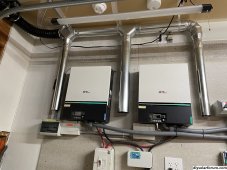Came across this installation. I can’t find any documentation on requiring this much spacing. The whole installation is kind weird. The nice; 3each Sol-Ark 15k on the exterior, 25kw propane generator, 25kw ground mount. I question the spacing, no master DC disconnect inside or exterior, no master PV disconnect near inverters, much of the array will be in shade at any given time and no optimizers. The battery cables are 2/0 and will be the same length(some doubled back in wire way) but cables have no markings. This a totally off grid system currently operating on generator. Some other issues. What do you think?





